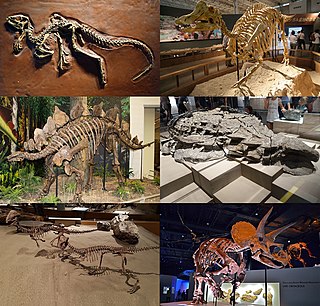
Ornithischia is an extinct clade of mainly herbivorous dinosaurs characterized by a pelvic structure superficially similar to that of birds. The name Ornithischia, or "bird-hipped", reflects this similarity and is derived from the Greek stem ornith- (ὀρνιθ-), meaning "bird", and ischion (ἴσχιον), meaning "hip". However, birds are only distantly related to this group as birds are theropod dinosaurs. Ornithischians with well known anatomical adaptations include the ceratopsians or "horn-faced" dinosaurs, the pachycephalosaurs or "thick-headed" dinosaurs, the armored dinosaurs (Thyreophora) such as stegosaurs and ankylosaurs, and the ornithopods. There is strong evidence that certain groups of ornithischians lived in herds, often segregated by age group, with juveniles forming their own flocks separate from adults. Some were at least partially covered in filamentous pelts, and there is much debate over whether these filaments found in specimens of Tianyulong, Psittacosaurus, and Kulindadromeus may have been primitive feathers.

Thyreophora is a group of armored ornithischian dinosaurs that lived from the Early Jurassic until the end of the Cretaceous.
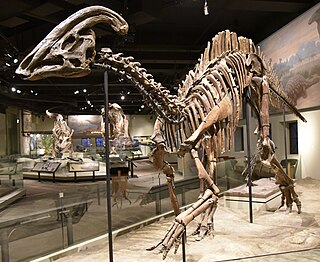
Ornithopoda is a clade of ornithischian dinosaurs, called ornithopods, that started out as small, bipedal running grazers and grew in size and numbers until they became one of the most successful groups of herbivores in the Cretaceous world, dominating the North American land. Their major evolutionary advantage was the progressive development of a chewing apparatus that became the most sophisticated ever developed by a non-avian dinosaur, rivaling that of modern mammals such as the domestic cow. They reached their apex of diversity and ecological dominance in the hadrosaurids, before they were wiped out by the Cretaceous–Paleogene extinction event along with all other non-avian dinosaurs. Members are known from all seven continents, though they are generally common in the Southern Hemisphere.

Marginocephalia is a clade of ornithischian dinosaurs that is characterized by a bony shelf or margin at the back of the skull. These fringes were likely used for display. There are two clades included in Marginocephalia: the thick-skulled Pachycephalosauria and the horned Ceratopsia. All members of Marginocephalia were primarily herbivores. They basally used gastroliths to aid in digestion of tough plant matter until they convergently evolved tooth batteries in Neoceratopsia and Pachycephalosauria. Marginocephalia first evolved in the Jurassic Period and became more common in the Cretaceous. They are basally small facultative quadrupeds while derived members of the group are large obligate quadrupeds. Primitive marginocephalians are found in Asia, but the group migrated upwards into North America.
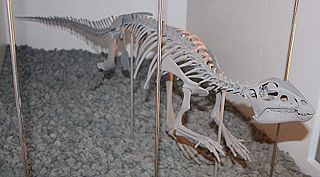
Hypsilophodontidae is a traditionally used family of ornithopod dinosaurs, generally considered invalid today. It historically included many small bodied bipedal neornithischian taxa from around the world, and spanning from the Middle Jurassic until the Late Cretaceous. This inclusive status was supported by some phylogenetic analyses from the 1990s and mid 2000s, although there have also been many finding that the family is an unnatural grouping which should only include the type genus, Hypsilophodon, with the other genera being within clades like Thescelosauridae and Elasmaria. A 2014 analysis by Norman recovered a grouping of Hypsilophodon, Rhabdodontidae and Tenontosaurus, which he referred to as Hypsilophodontia. All other analyses from around the same time have instead found these latter taxa to be within Iguanodontia.
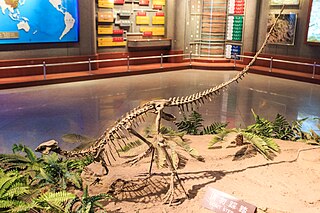
Agilisaurus is a genus of ornithischian dinosaur from the Middle Jurassic Period of what is now eastern Asia. It was about 3.5–4 ft long, 2 ft in height and 40 kg in weight.

Echinodon is a genus of heterodontosaurid dinosaur that lived during the earliest Cretaceous of southern England and possibly western France in the Berriasian epoch. The first specimens were jaw bones named Echinodon becklesii by Sir Richard Owen in 1861, and since their original description only additional teeth have been discovered. The specific name honours collector Samuel Beckles who discovered the material of Echinodon and many other taxa from across England, while the genus name translates as "prickly tooth" in reference to the dental anatomy of the taxon.

Micropachycephalosaurus is an extinct genus of basal ceratopsian dinosaur containing only the type species, Micropachycephalosaurus hongtuyanensis. It lived in China during the Late Cretaceous (Campanian) and was found in the Jiangjunding Formation.
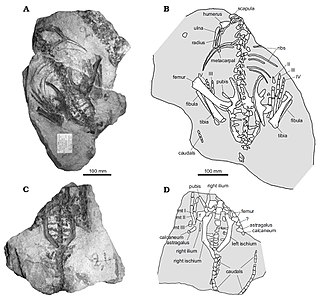
Stenopelix is a genus of small marginocephalian dinosaur, possibly a basal ceratopsian, from the Early Cretaceous of Germany. It lived in the late Berriasian Stage of the Cretaceous period, approximately 140 myr ago. The genus is based on a partial skeleton lacking the skull, and its classification is based on characteristics of the hips.

Neornithischia is a clade of the dinosaur order Ornithischia. It is the sister group of the Thyreophora within the clade Genasauria. Neornithischians are united by having a thicker layer of asymmetrical enamel on the inside of their lower teeth. The teeth wore unevenly with chewing and developed sharp ridges that allowed neornithischians to break down tougher plant food than other dinosaurs. Neornithischians include a variety of basal forms historically known as "hypsilophodonts", including the Parksosauridae; in addition, there are derived forms classified in the groups Marginocephalia and Ornithopoda. The former includes clades Pachycephalosauria and Ceratopsia, while the latter typically includes Hypsilophodon and the more derived Iguanodontia.
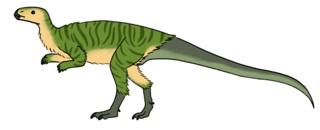
Changchunsaurus is an extinct genus of small herbivorous dinosaur from Early Cretaceous deposits of Gongzhuling, Jilin, China. It is the first named dinosaur genus from Jilin.
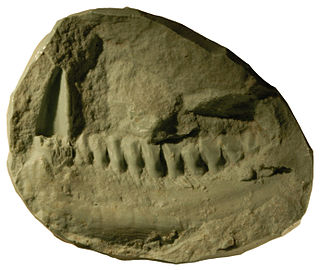
Lycorhinus is a genus of heterodontosaurid ornithischian dinosaur from the Early Jurassic strata of the Elliot Formation located in the Cape Province, South Africa.

Heterodontosauridae is a family of ornithischian dinosaurs that were likely among the most basal (primitive) members of the group. Their phylogenetic placement is uncertain but they are most commonly found to be primitive, outside of the group Genasauria. Although their fossils are relatively rare and their group small in numbers, they have been found on all continents except Australia and Antarctica, with a range spanning the Early Jurassic to the Early Cretaceous.

Genasauria is a clade of extinct beaked, primarily herbivorous dinosaurs. Paleontologist Paul Sereno first named Genasauria in 1986. The name Genasauria is derived from the Latin word gena meaning ‘cheek’ and the Greek word saúra (σαύρα) meaning ‘lizard.’ It is hypothesized that Genasauria had diverged from Lesothosaurus by the Early Jurassic. Cranial features that characterize Genasauria include a medial offset of the maxillary dentition, a sprout-shaped mandibular symphysis, moderately sized coronoid process, and an edentulous anterior portion of the premaxilla. A distinguishing postcranial feature of Genasauria is a pubic peduncle of the ilium that is less robust than the ischial peduncle. Genasauria is commonly divided into Neornithischia and Thyreophora. Neornithischia is characterized by asymmetrical distributions of enamel covering the crowns of the cheek teeth, an open acetabulum, and a laterally protruding ischial peduncle of the ilium. Neornithischia includes ornithopods, pachycephalosaurs, and ceratopsians. Thyreophora is characterized by body armor and includes stegosaurs, ankylosaurs, Scelidosaurus, and Scutellosaurus.
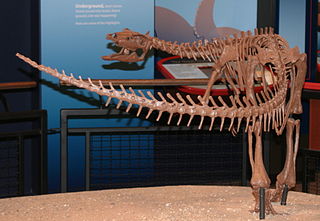
Thescelosauridae is a clade of neornithischians from the Cretaceous of Asia, North America and possibly South America. The group was originally used as a name by Charles M. Sternberg in 1937, but was not formally defined until 2013, where it was used by Brown and colleagues as the group uniting Thescelosaurus and Orodromeus, based on their phylogenetic results. During a phylogenetic revision of neornithischians by Clint Boyd in 2015, the authorship of Thescelosauridae was given to Brown and colleagues, which meant that the similar name Parksosauridae, informally defined in 2002 by Buchholz, would have had priority over Thescelosauridae. The two clades had slightly different definitions, with Parksosauridae referring to all animals closer to Parksosaurus than Hypsilophodon, but they contained the same taxa so Boyd used Parksosauridae under the assumption it had priority. However, in formalizing the clade following the regulations of the PhyloCode, Madzia, Boyd, and colleagues identified in 2021 that Sternberg was the proper authority for Thescelosauridae, giving it priority over Parksosauridae. As well, they gave Thescelosauridae the definition of the largest clade containing Thescelosaurus neglectus but not Iguanodon bernissartensis, as long as Hypsilophodon foxii was not in the group, modifying previous definitions for Thescelosauridae in order to maintain its modern use, so that the clade was not applied if Thescelosaurus fell within Hypsilophodontidae, a family that has not been recently used but may be revived if the systematic position of Hypsilophodon was solidified at some point in the future. Madzia et al. identified the analysis of Madzia et al. in 2018 as the reference analysis for the name Thescelosauridae, an analysis based on a revised version of the 2015 Boyd analysis.

Helioceratops is a genus of herbivorous neoceratopsian dinosaur from the Middle Cretaceous of China.

Fruitadens is a genus of heterodontosaurid dinosaur. The name means "Fruita teeth", in reference to Fruita, Colorado (USA), where its fossils were first found. It is known from partial skulls and skeletons from at least four individuals of differing biological ages, found in Tithonian rocks of the Morrison Formation in Colorado. Fruitadens is one of the smallest known ornithischian dinosaur, with young adults estimated at 65 to 75 cm in length and 0.5 to 0.75 kg in weight. It is interpreted as an omnivore and represents one of the latest-surviving heterodontosaurids.

Ankylopollexia is an extinct clade of ornithischian dinosaurs that lived from the Late Jurassic to the Late Cretaceous. It is a derived clade of iguanodontian ornithopods and contains the subgroup Styracosterna. The name stems from the Greek word, “ankylos”, mistakenly taken to mean stiff, fused, and the Latin word, “pollex”, meaning thumb. Originally described in 1986 by Sereno, a most likely synapomorphic feature of a conical thumb spine defines the clade.























